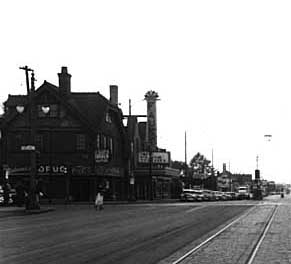Difference between revisions of "Faust Theater"
(table) |
|||
| Line 1: | Line 1: | ||
<div style="text-align: center;"> | <div style="text-align: center;"> | ||
| − | '''Southwest corner of Dale Street and University Avenue, St. Paul, MN''' | + | '''Southwest corner of Dale Street and University Avenue, St. Paul, MN (1912-1974-1990)''' |
</div> | </div> | ||
Revision as of 22:10, 26 March 2010
Southwest corner of Dale Street and University Avenue, St. Paul, MN (1912-1974-1990)
| The Faust in 1952, before it showed pornographic films. Courtesy of the Minnesota Historical Society. |
St. Paul's University Avenue reflected changes in the city for most of the 20th century--it began as a streetcar strip with neighborhood-oriented businesses(1); it attracted auto dealerships, big band performances, and drive-ins mid-century(2); in the past 30 years, the street has attracted a large neighborhood of Hmong immigrants(3).
|
The Faust began as many other neighborhood theaters did--it was a 1910s-era neighborhood showplace for families and single people who rented in the area. By 1974, the theater followed a national trend and switched to playing X-rated films.(4)
The theater's gravitational pull attracted several forms of sexually unaccepted individuals--prostitutes, porn enthusiasts, public masturbaters, and men who engaged in public sexual activity with other men. This last class of sexual misfit has co-existed with the others for much of contemporary urban life. Local historian Jean-Nickolaus Tretter, director of the Jean-Nickolaus Tretter Collection and longtime resident of the area, suggested that the Faust's queer male activity was catered to "dirty old men." Tretter notes that the Faust did not carry the social benefits that the Adonis/Flick Theaters did across the river in Minneapolis.(5)
In the 1980s, former St. Paul mayor Geroge Latimer rode with St. Paul police as they used undercover officers to entrap and arrest "Johns." The mayor used this experience as justification for his campaign against the area's sexual nonconformity.(6) Using eminent domain--the government-sanctioned seizure of property for public benefit--the city of St. Paul paid the Faust's owner and his family to leave town. The city of St. Paul demolished the historic building, and the Faust's owner simply moved his business to the Warehouse District, opening a new pornography megaplex, entitled "Deja Vu."(7)
(1)Diers, John W., and Isaacs, Aaron. Twin Cities By Trolley: The Street Car Era in Minneapolis and St. Paul. Minneapolis: University of Minnesota Press, 2007. Page 35.
(2) Wilcoxen, William. "An Entertainment Destination." Minnesota Public Radio: 5/28/2008
(3)Yo Ping Lai, Eric. The New Face of Asian Pacific America: Numbers, Diversity, and Change in the 21st Century. San Francisco: AsianWeek Books, 2003. Page 98.
(4)Johnson, Dirk. "A Showcase for Sex is Run out of Town." The New York Times, 4/29/1990.
(5) Tretter, Jean-Nickolaus. Interview with the author, 2/28/10
(6) Wilcoxen, Ibid.
(7) Johnson, Ibid.
Part of Minneapolis/St. Paul, MN: 100 Queer Places in Minnesota History, (1860-1969), (1969-2010)
